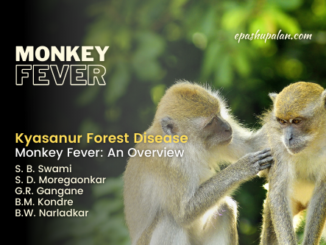HISTORY
This disease is known since 200 BC, the first rabies case was recorded in Mesopotamian codex of eshnunna. In ancient Greece rabies was supposed to be caused by lyssa (THE SPIRIT OF MADE RAGE), the first epizootic of rabies reported in in Boston in 1768. Actual cause of rabies was reported by louis Pasteur and in 1885 nerve tissue vaccine was successfully tested by him and it was progressively improved to reduce side- effects. Here the term rabies derived from the Latin word “rabere” that means “to be mad” and the same in Sanskrit word “Rabhas” means violent. Rabies is a fatal disease that poses a large number of deaths in the present-day world especially in small children, goat kids, calf, pigs, and dogs, here the dog acts as the main source of infection to all the other domestic animals. It is estimated that about 59000 individuals die every year in Africa and the Asian continent especially the children. The main route of infection is by contact with the saliva of infected animals that are shedding the viral particles in the saliva, through the scratches on the body and accidental bite of the dogs or any other wild carnivores like tiger, fox cheetah. As in the rural scenario of underdeveloped and developing nations without the knowledge of people let the exposure without bothering it in further days turned out as an untreatable life-taking condition as we all know the rabies is such a zoonosis or condition that cannot be treated after the exhibition of symptoms. In the present society world restrictions like the World Health Organisation (WHO), the organization for animal health (OIE), and the Centre for Disease Control (CDC) striving to avoid the death of both animals and humans due to rabies caused by both ignorance and lack of timely measures implementation in the communities of high risk. On the occasion of world rabies day of 2020, they have set a strong goal of elimination of rabies by following “Vaccination and Collaboration” as the theme setup to realize and escorting the earlier determined goal of elimination of rabies by 2030.
If we move into knowing rabies it starts up as follows rabies is a preventable life-threatening viral zoonotic disease that infects all the warm-blooded animals. As it is a stronger neurotrophic virus it mainly destroys the nerves in the body of infected animals, some of the reservoirs of rabies virus are bats, raccoons, skunks, and foxes, and the vampire bats.
VIRUS CLASSIFICATION
| PHYLUM | Negarnaviricola |
| CLASS | Monjiviricetes |
| ORDER | Mononegavirales |
| FAMILY | Rhabdoviridae |
| GENUS | Lyssavirus |
VIRUS STRUCTURE
The virus with non-segmented negative-sense RNA genomes rabies virus is typically bullet-shaped as it is also an important characteristic of a virus belonging to the Rhabdoviridae family the structure of the virus is as follows length is about 180 nm long is about 75nm width and it is made up of my proteins namely that is the nuclear protein(N), phosphoprotein (P), Matrix protein(M), glycoprotein(G) and polymerase(L).
The complete genome sequences range from 11615 to 11966 nucleotide (nt) in length and the replication and transcription takes place in cytoplasm inside virus factory that is NEGRI BODY (named after adelchi negri).This structure is considered as histological proof of such infection.
ROUTES OF INFECTION
The bite of infected animals the contact of saliva with abraded skin and mucosal surface after the entry of virus in the body of animals and also humans it multiplies in the myocytes at a particular site and gains entry into the nerves nearby virus particles upon multiplication at high numbers move towards the brain at an estimated speed of about 8 to 20 mm per day, once the virus particles reach the brain tissue they multiply enormously and moved to the salivary gland and start shedding in the saliva it also reaches to all the parts of the body in a centripetal fashion. Main effects that are exerted by the rabies virus are as follows the causes paralysis of respiratory, deglutition, and mastication muscles. All the nerves in the body undergo paralysis and impulse transmission is enormously affected due to the mitochondrial dysfunctions that are resulted from the action of the virus in the nerve cells.
SYMPTOMS
Lethargy, vomiting, nausea, mild fever, and this progress within a short time into cerebral dysfunction, ataxia, weakness, paralysis, seizures causes difficulty in breathing and swallowing and aggressive behaviour self-mutilation ultimately leads to the death of the affected animals or man will finally die due to the lack of treatment in early-stage ie chemoprophylaxis immediately after exposure to the virus.
DIAGNOSIS
- Lateral flow assay using saliva as a material for testing
- Monoclonal antibody test
- Quantitative ELISA
- The fluorescent antibody test is carried out by taking the hair follicle for the nuchal ligament of suspected animals.
- Histological tests like mann’s test can be done after fixation of tissue material using paraffin embedding test.
- Brainstem used are fixed in high grade cold acetone and stained with a drop of specific conjugate.
Collection of Brain Samples for Rabies Diagnosis
- Occipital foramen route for brain sampling: A 5mm drinking straw or 2ml disposable plastic pipette is introduced into occipital foramen in the direction of eye, from this samples from cerebellum, hippocampus, cortex, medulla oblangata can be collected to detection of inclusion bodies in the sample.
- Retrobulbar route of sampling: Hole is made on posterior wall of eye socket, plastic pipette introduced through this hole to collect the brain samples.
DIFFERENTIAL DIAGNOSIS
It should be differentiated with all other cause of encephalitis as it is initial sign of rabies and also in particular infections like herpesviruses, enteroviruses, arboviruses such as west nile virus. New causes of viral encephalitis are also possible. The evidence of it can be traced by 1999 outbreak in the Malaysia with the mortality rate of about 40% that was caused by nipah virus that belonging to family: Paramyxoviridae, sub-family: Henipa virus.
Post-mortem examination
By taking the brain sample of suspected dead animals taking the brain Impressions are prepared and fixed with ethanol and stained with the sellar stain we observe intracytoplasmic inclusions Negri bodies in the microscope and CSF examination for the quantitative examination of virus and also the myocytes at the bite site of dog.
This disease is very much pathogenic it cannot be treated after the exposure of clinical signs but it can be prevented by the implementation of some of the procedures that are Pre-bite vaccination in the endemic areas.
Post-bite vaccination to be carried out as per the standard regulation of WHO, CDC and OIE are: Bite site must be thoroughly washed by the soap and detergents containing iodine and immunoglobulin to be given by following the vaccination schedule of 0,3,7,14,28 days respectively. If any deep cut or wound is found they are applied with the spirit or povidone solution.
Two types of immunoglobulins are as follows
- Human rabies immunoglobulin (HRIG)
- Equine rabies immunoglobulin (ERIG)
Use of ribavirin a purine analogue that acts as an immunomodulator and ketamine is an anaesthetic agent that crosses the blood-brain barrier to avoid the in vitro-multiplication of rabies virus along with immunoglobulin has given efficient results in therapy, antibiotics can be used to avoid hypoxia in the brain.
The present-day advances in rabies therapy are as follows that is the monoclonal antibodies RVC 20 and RVC 58 with a broad spectrum of activity in vitro both of them can neutralize all 35-rabies virus and 25 non-rabies virus lyssaviruses and some of the therapeutic measures are
APTAMERS
- Single standard oligonucleotides with low molecular weight about 5 to 40-kilo dalton
- Bind to target molecules efficiently
- It is thought of importance as it enters the blood-brain barrier due to its small structure
CONTROL AND PREVENTION
By reducing the stray dog population, immunization of the stray dogs for a yearly basis. To avoid the spread of the virus through the wild population they should be extensively vaccinated. By these measures Australian and European regions are declared as completely rabies-free. To spread awareness to the people all around the globe about rabies it’s spread, preventive and prophylactic measures and post-vaccination and make them cautious and enable to fight against this may help in complete eradication of rabies in upcoming days as our main responsibility is to protect ourselves then the whole world will be protected.






Nice article 👍